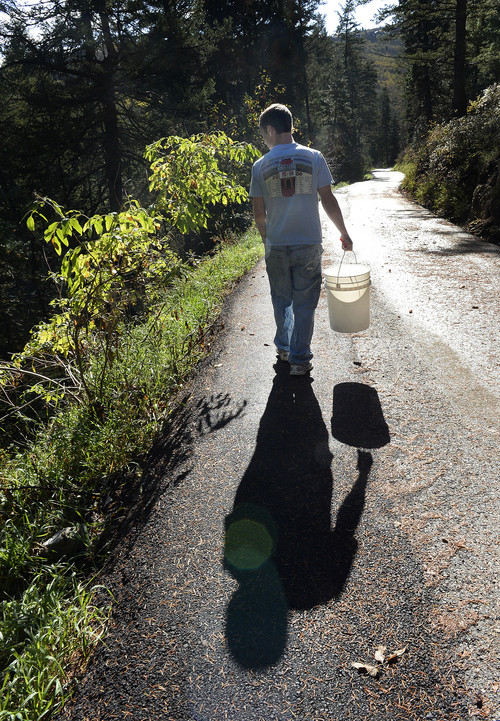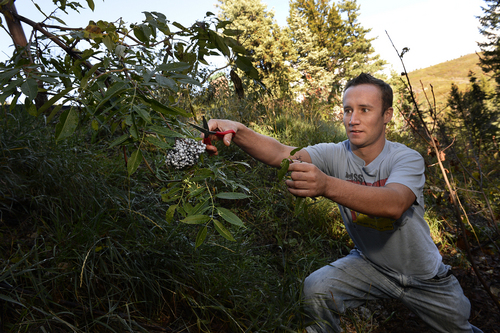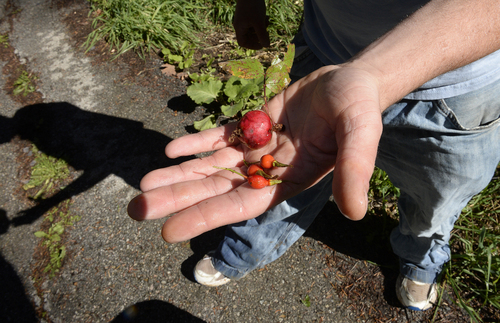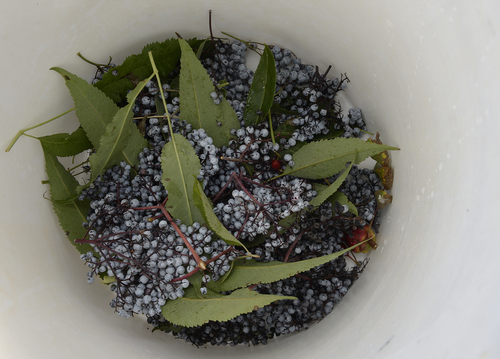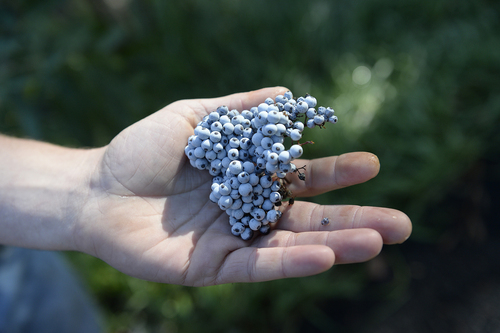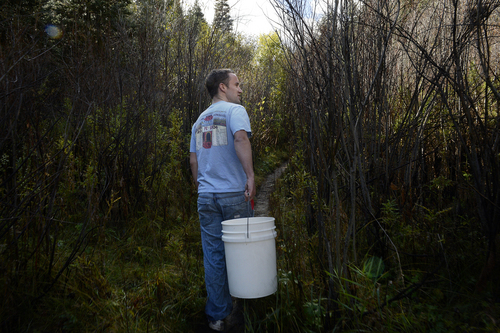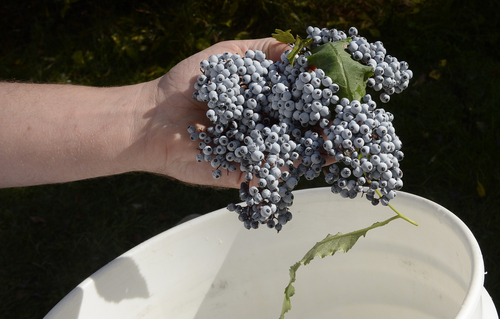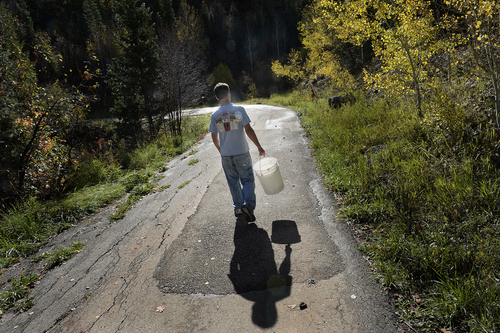This is an archived article that was published on sltrib.com in 2014, and information in the article may be outdated. It is provided only for personal research purposes and may not be reprinted.
After spending the summer inside the hot kitchen — cooking for wedding guests, concertgoers and outdoor enthusiasts — the chefs at Deer Valley Resort look forward to those cool fall days when they can get outside and forage for elderberries.
Harvesting is easy, as the slopes surrounding the Park City resort are laden with the woody shrubs that produce clumps of the dusty-blue fruit.
Besides, it would be a shame if the birds, deer and other wildlife were the only creatures to enjoy this wild delicacy that has sustained civilizations for centuries.
They "add that tang" to sauces and other dishes, says Ryan Swarts, the chef at the resort's new Brass Tag restaurant. The 26-year-old New Jersey native is just starting his sixth season at the resort, where he arrived about the same time the elderberry foraging tradition began.
Swarts said the berries are especially abundant around the Royal Street and Empire Canyon lodges, but can be found all over Summit County.
"We've been driving in the Deer Valley van before and seen them growing on the side of the road," he said. Never one to waste good fruit, "we jumped out in our chef whites to harvest them."
During a late-season foraging excursion near Parleys Summit last week, Swarts said the 2014 elderberry crop seemed to ripen a few weeks earlier than in previous years — likely because of the rain. And the birds and squirrels seemed to take more than their usual share — a possible sign that Northern Utah could be in for "a crazy winter," he said.
Throughout the season, the Deer Valley foragers — who also include food and beverage director Julie Wilson and executive chef Jodie Rogers — were able to harvest three 5-gallon buckets of fruit this fall. It will be cooked down into a sweet juice and made into jelly. In years when there has been more fruit, the kitchen also has produced a sweet elderberry syrup that is used in the bakery and for cocktails.
Whole berries, even though they contain seeds, also make excellent pies. The tiny seeds are virtually undetectable when baked in a pie.
Diners who want to try the elderberry jelly should order the Brass Tag's cheese board, a $10 offering on the appetizer menu. The jelly is served alongside double-cream brie and pickles — all made inside the Deer Valley kitchens.
The jelly also may show up in venison and other meat specials.
"Every year I like to play around with it," said Swarts, a graduate of the Culinary Institute of America who worked — and foraged — in the mountainous Piedmont region of Italy.
While foraging in Utah, Swartz regularly comes across more than just elderberries. Ramps, a kind of wild leek, are a usual find; so are gooseberries and rose hips — red berries that are good for meat glazes. With such an abundance of wild food, he has been researching how to cook with cattails and has the urge to do some mushroom foraging.
—
What's in a name • A member of the honeysuckle family, the elderberry gets its name from the Anglo-Saxon word aeld — which means fire, "for the tree's hollow stems, which were used for blowing on a fire to get it started," Janie Hibler writes in her culinary book, "The Berry Bible."
There are nearly two dozen species of elderberry in the Northern Hemisphere. They thrive in wooded, mountainous areas and, depending on the species, will produce red, blue, black or white berries in the fall. Avoid the red berries, Hibler notes, as they can cause an upset stomach.
The elderberry bush is "really all over the Wasatch," said John Francis, who along with his wife, Casee, owns Salt Lake City's Amour Spreads.
The couple have foraged everywhere from Snowbasin and Emigration Canyon to Guardsman Pass and Mount Pleasant for the fall fruit that is used in their elderberry orange marmalade.
"We've never found a place that grows them commercially," he said, "so if you want to make something out of elderberries, you have to go get them."
Francis said after playing around with different combinations, including pears and plums, which also are in season in late fall, the couple decided that the early Valencia oranges were "a lovely pairing" for elderberries.
"The orange cuts that woodsiness that they have," he said, adding that this year's batch — only about 200 jars — will be available on Saturdayat the Salt Lake City Downtown Farmers Market at Pioneer Park for $8 (4-ounce jar) and $12 (9-ounce jar).
Foraging of elderberries is a Utah tradition that dates back centuries. American Indians in the region not only consumed the fresh berries, they found several uses for the entire plant, according to information from Utah State University Extension Services.
These early inhabitants used the leaves and bark for medicinal purposes. The larger limbs were made into arrow shafts and the smaller, hollow stems were used as flutes or whistles to bugle for elk, the USU information states.
There are other historical references to elderberries all over the world. In Greece, Hippocrates wrote about their healing properties; Romans used the berries as hair dye and in wine; and in England the bushes were planted near cottages and were believed to keep away witches.
Elderberry Jelly
3 cups prepared juice (from 3 pounds ripe elderberries)
¼ cup fresh lemon juice
1 box SURE-JELL Fruit Pectin
1 tablespoon fresh rosemary picked of stem and chopped
½ teaspoon butter or margarine
4 ½ cups, sugar, measured into separate bowl
Special equipment
Water bath canner
Five 1-cup canning jars
Flat lids and screw bands
Bring boiling-water canner, half full with water, to simmer. Wash jars and screw bands in hot soapy water; rinse with warm water. Pour boiling water over flat lids in saucepan off the heat. Let stand in hot water until ready to use. Drain well before filling.
Remove and discard large stems from elderberries. Crush fruit thoroughly; place in saucepan. Cook on medium heat until juice starts to flow, stirring occasionally. Reduce heat to low, cover and simmer 15 minutes, stirring occasionally. Place 3 layers of damp cheesecloth or jelly bag in large bowl. Pour prepared fruit into cheesecloth. Tie cheesecloth closed; hang and let drip into bowl until dripping stops. Press gently. Measure exactly 3 cups prepared juice into 6- or 8-quart saucepot. (If necessary, add up to ½ cup water for exact measure.) Stir in lemon juice.
Stir pectin into juice in sauce pot. Add fresh rosemary and butter to reduce foaming. Over high heat, bring mixture to full rolling boil (a boil that doesn't stop bubbling when stirred), stirring constantly. Stir in sugar. Return to full rolling boil and boil exactly 1 minute, stirring constantly. Remove from heat. Skim off any foam with metal spoon.
Ladle immediately into prepared jars, filling to within ¼ inch of tops. Wipe jar rims and threads. Cover with two-piece lids. Screw bands tightly. Place jars on elevated rack in canner. Lower rack into canner. (Water must cover jars by 1 to 2 inches. Add boiling water, if necessary.) Cover; bring water to gentle boil. Process 5 minutes, or longer at high altitudes. (See note below.)
Remove jars from canner and place upright on towel to cool completely. After jars cool, check seals by pressing middles of lids with finger. (If lids spring back, lids are not sealed and refrigeration is necessary.)
High Altitude • At altitudes above 1,000 feet, increase processing time as indicated: 1,001 to 3,000 feet — increase processing time by 5 minutes; 3,001 to 6,000 feet — increase processing time by 10 minutes; 6,001 to 8,000 feet — increase processing time by 15 minutes; 8,001 to 10,000 feet — increase processing time by 20 minutes.
Servings • 5 cups, 1 cup jars
Source: SURE-JELL Fruit Pectin —
Elderberry-apple pie
3 ½cups fresh elderberries
¾ cup thinly sliced tart apples
1 tablespoon lemon juice
1 cup sugar
1/3 cup flour
Dough for one double-crusted pie
Butter
Heat oven to 400 degrees. Line an 8- or 9-inch pie pan with bottom crust. In a bowl, mix elderberries, apples, lemon juice, sugar and flour. Pour mixture into the pastry-lined pan and dot with butter. Cover with top crust. Trim and seal edges. Use a knife to make a few slits in the top. Place in the preheated oven and bake 35 to 40 minutes, or until crust is golden.
Servings • 1 pie
Source: Utah State University —
Elderberry-apple pie
3 ½cups fresh elderberries
¾ cup thinly sliced tart apples
1 tablespoon lemon juice
1 cup sugar
1/3 cup flour
Dough for one double-crusted pie
Butter
Heat oven to 400 degrees. Line an 8- or 9-inch pie pan with bottom crust. In a bowl, mix elderberries, apples, lemon juice, sugar and flour. Pour mixture into the pastry-lined pan and dot with butter. Cover with top crust. Trim and seal edges. Use a knife to make a few slits in the top. Place in the preheated oven and bake 35 to 40 minutes, or until crust is golden.
Servings • 1 pie
Source: Utah State University
—
Elderberry liqueur
1 pint fresh elderberries
1 quart vodka
3 (1-inch) pieces of lemon rind, white pith removed
1/3 cup sugar
Put elderberries into a quart Mason jar and pour over the vodka. Add lemon rind (make sure the rind has no white pith, as it is bitter). Seal and put in a dark cupboard for at least a month, or up to 6 months. The alcohol will extract flavor from the elderberries over time, so the longer you let it sit, the inkier it will get.
When it is the color you want — anything from a pinot noir color to downright black — pour the vodka through a strainer lined with cheesecloth into another jar and add sugar. Shake to combine and put back in the cupboard.
After a few days or weeks, the sugar will completely dissolve and the elderberry liqueur is ready to drink. It keeps forever.
Servings • 1 quart
Source: Hank Shaw, author of "Hunt, Gather, Cook" and "Duck, Duck, Goose"


